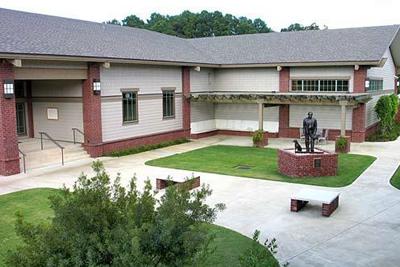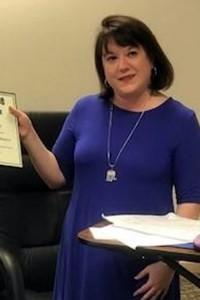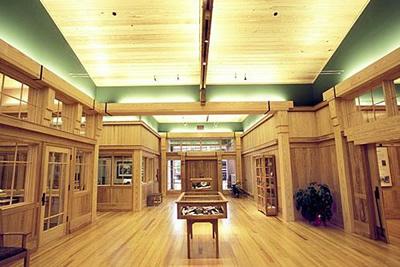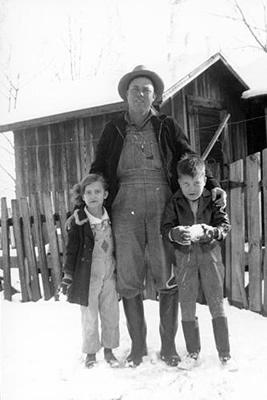
The History Center in Diboll
 August 26, 2019 - “The women are there, you just have to look a little harder to find them when doing genealogical research,” Emily Hyatt, Certified Archivist at Diboll's History Center told the Timpson Area Genealogical and Heritage Society's August 21st meeting.
August 26, 2019 - “The women are there, you just have to look a little harder to find them when doing genealogical research,” Emily Hyatt, Certified Archivist at Diboll's History Center told the Timpson Area Genealogical and Heritage Society's August 21st meeting.
“Since there are fewer official records of women's activities” Hyatt said, “ I hope to give you some ideas about alternative sources of information for genealogists researching female ancestors.” She also shared a number of vintage photographs from The History Center's collection, some of which she said were among her favorites.
Located on Highway 59 in Diboll, The History Center began in 1976 as part of the Bicentennial celebration. In the 1980's the Diboll Historical Society began adding more collections and oral histories to The History Center. In 1986 the Diboll Historical Society published a history of Diboll entitled The Cornbread Whistle. Established as a company town by Thomas L. Temple's Southern Pine Lumber Company in 1894, Diboll's economy has always been based upon the sawmill Temple built there. “Mr. Temple said he didn't want to 'cut out and get out' but rather, to establish a town which would last. To that end, he made sure the town had a public library, a variety of churches, and more amenities than usual for a small East Texas town.”
Every day at 11:15 AM the mill blew a steam whistle which could be heard all over town. Over the years, the reason why the whistle was blown every morning was lost and one day the mill management decided not to blow it. “When the workers got home for lunch they found that it wasn't ready because the homemakers used the whistle to know when it was time to put the cornbread in the oven,” Hyatt relates. Now known as “The Cornbread Whistle, it can be heard each weekday at 11:15.
“Our goal is to collect, preserve, and make available the history of Diboll, Angelina County, and the surrounding area, which means we hold collections relating to the timber industry, cities in the area, counties, local organizations, and families.” said Hyatt. “We have permanent exhibits on lumber camps, boxcar houses, and education as well as other collections which change periodically. For example, we had an exhibit commemorating the end of World War II which told the story of the war from a local perspective and featured items provided by local residents.”
A popular exhibit not in the museum but on the grounds is a 1920 steam locomotive with log car and caboose which once hauled logs to the mill. “Children who visit the museum are often disappointed to find that the locomotive doesn't move but we do have the whistle connected to an air compressor and visitors can sound it. We also have exhibits in the caboose,” she said.

The interior of the History Center.
“All of the plants on the grounds of the museum are native not just to East Texas but to our area. We worked with the Native Plant Center at Stephen F. Austin State University to ensure that we got it right,” continued Hyatt. “We soon will have bright red cardinal flowers blooming and in the spring we have native cornflowers. Our grounds are a showplace for what can be done by landscaping with native plants.”
 The museum features a 2000 square foot climate-controlled vault for the preservation of photographs and records which have been donated. “We have archives of the Lufkin Daily News and the Diboll Free Press, neither of which is available online. We also have the records of The Southern Pine Lumber Company, Lufkin Foundry, and many local businesses which no longer exist,” she added. She explained that frequently the records they receive are dirty and in disarray and must be cleaned and organized in their processing area prior to being archived, a process that can take years for some of the largest collections they receive.
The museum features a 2000 square foot climate-controlled vault for the preservation of photographs and records which have been donated. “We have archives of the Lufkin Daily News and the Diboll Free Press, neither of which is available online. We also have the records of The Southern Pine Lumber Company, Lufkin Foundry, and many local businesses which no longer exist,” she added. She explained that frequently the records they receive are dirty and in disarray and must be cleaned and organized in their processing area prior to being archived, a process that can take years for some of the largest collections they receive.
“In the past, women had official roles in society and government much less often than they do now, so the records of their lives are harder to find. However, I am less interested in what people did than who they were, and that is where we find women's contributions reflected,” Hyatt revealed. Census records reveal how many children a woman had, although there are frequently errors. “Funeral home records are great for names and dates as well as who paid for a funeral, who performed a funeral, and church affiliation. We have all of the old records from Gipson Funeral Home of Lufkin.”
“Church records are a valuable source of information on women because women were always involved in church life. They didn't just attend church, they taught Sunday School, Vacation Bible School, and sang in the choir,” she said. Sometimes there are photographs which are valuable sources of information. “Women were usually the family historian, keeping family birth, death, and marriage records by writing them in the family Bible.”
Since women attended public school and frequently taught school, school records are an important source of data. The County School Superintendent position no longer exists and those records, as well the records of small schools which have closed over the years, can offer a trove of information on our ancestors. The History Center has Angelina County School Superintendent's records as well as the records of the Diboll PTA, she added. “Class pictures and old yearbooks are also revealing,” she said. The History Center has a complete set of Diboll school yearbooks and they are a popular attraction for those who want to show their grandchildren what they looked like when they were young.
The History Center's collection of records from The Southern Pine Lumber Company, Temple Industries, and other large employers in the area offer insight into the jobs individuals held, dates worked, and pay scale. Women made up only a small portion of the workforce prior to WWII, but that all changed when war came. “Lufkin Industries manufactured war materiel and women filled the positions previously held by men who had gone into the military during the war. We have those records,” Hyatt shared. “Most counties created a book of those who served in the military during WWII and the women who served are included.”
“Probably the most interesting source for information about women for me is in their club records”, she revealed. “Women were well represented in service clubs, hobby clubs, professional clubs, garden clubs, and literary clubs. Angelina County had a Temperance Society and we have photographs of some of their activities. We also have the records of the Lufkin County Red Cross, who raised money for refugee relief and made sure that soldiers who stopped in Diboll on their way to training were given a box lunch,” said Hyatt.
“Many women kept scrapbooks and they are a unique place to find information,” Hyatt said. “On that subject, let me remind all of you that someday the photographs you take will be used by your descendants for information about you. Please be sure to identify the people and subjects of the photographs! We have thousands of photographs which have been donated by families who no longer know who the people in the pictures are.”
“I was really excited recently when we received a collection of photographs and letters from Mr. Shannon Ramsey of Timpson, a member of TAGHS,” Hyatt remarked. “This collection came from his grandmother, Esther Pennington Ramsey. It is a remarkable collection of 800 pieces of correspondence written to Mrs. Ramsey, who was born in 1888 and died in 1972. The letters reveal much about Mrs. Ramsey, the people who wrote them, and life in Texas during the period.” she said. “It is an amazing collection and Mr. Ramsey had done wonderful job of preparing them for presentation to us.”
The History Center is located on Highway 59 in Diboll. “We are open 8 to 5 on weekdays and from 9 until 1 on Saturdays. We have clean restrooms and if you're on your way to or from Houston we invite you to stop in, look around, and maybe blow the train whistle,” laughed Hyatt.
The Timpson Area Genealogical and Heritage Society meets at 2PM on the third Wednesday of each month in the Meeting Room of the Timpson Public Library, located on the corner of Austin and Bremond Streets in Timpson. The public is invited. The TAGHS Genealogy Library is located inside the Timpson Public Library and is staffed by TAGHS volunteers who are available to assist those doing research. The phone number is 936-254-2966.









